BlogRSS
Pedro Rodriguez

Born in Valencia in 1895, Pedro Rodriguez became apprenticed to a tailor when he was just ten. While still a teenager he was designing on his own and founded his fashion house in Barcelona in 1919, which was the first to be opened in Spain.
His work became very popular after a showing at the Barcelona Fair in 1929, making him especially known for his beadedStrike a Pose. Fashion in portraits
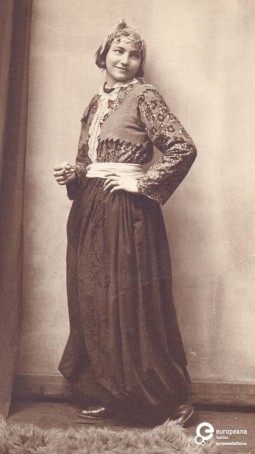
‘Strike a pose’ is a very common expression in fashion, referring to the idea of ‘posing’ in front of the objective of a photographer. However, posing is not something we find just in fashion editorials; it is a sort of acting, performed by people in many portraits and photographs.

Group portrait of three girls in an outdoor environment in Lima, Dalarna, 1925-35, Courtesy Stiftelsen Nordiska Museet
These ‘representations’ are less directly linked to the fashion system; nevertheless, they have the capability to convey information about the complex and ever-changing relationship between people and their dress, identity and sartorial choices. Photographic portraits are fascinating as they are enigmatic. They are testimonies, incredibly valuable sources to study, understand and appreciate fashions and styles of the past, as they were interpreted and lived by people in their everyday.

Portrait of Mina Hadzi Paskovic dressed as a gipsy woman, 1931, Courtesy Museum of Applied Art, Belgrade
Looking at these materials, we can analyse customs and manners, even the personalities and attitudes of the people ‘captured’ in the shoots; why are they wearing those clothes? How did they pick them, and what do they mean for them? What do the clothes say about the time in which the photograph was taken, and about class, social status, history more generally? Every photograph tells a particular story, freezes a moment and allows us to actually see the way in which clothes were used and styled in real life: dresses and accessories are like props, and their very use, shown in the photos, becomes the material memory.

Portrait of a couple in the countryside of Lima, Dalarna, 1925-35, Courtesy Stiftelsen Nordiska Museet
Most of the times though, it is very difficult to be able to grasp the full story just by looking at a photograph. The relationship between a person and the clothes chosen for that photo is so intimate and linked to personal experiences, that it is hard to tell the real reason why that particular dress was selected to be immortalised in the photograph. Under this respect, the photograph in itself is a designed object, controlled in every part; it speaks about the character of the sitter, his or her way to be presented and to be remembered, and this is its most beguiling characteristic. Small details – the length of a skirt, the fit of a jacket or a dress, the expression of comfort or discomfort of the sitter, his or her position – are the hints to read between the lines and built a deeper and fascinating understanding of the story behind this alternative example of ‘paper fashion’.
The Europeana Fashion portal holds many of these precious objects: those presented alongside this article are but a few. Search our collection to find out more about these alternative ways of ‘seeing through clothes’.
Dress to Disguise and Play: The Masquerade
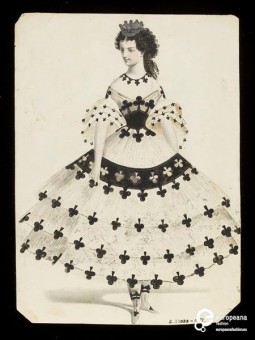
The performative quality of clothes is so strong that it also create the space to become someone else, even just for a little while. Masquerades have been, for centuries, events designed especially to play this game, and costumes were its absolute protagonists.

'Queen of Clubs’, watercolour drawing by Jules Helleu of a masquerade ball dress, probably for Charles Frederick Worth. Paris, 1860s, Courtesy Victoria & Albert Museum, CC-BY-SA
The existence of masquerades – as designed social gatherings where the participants had to wear a costume – can be dated back to the 15th century; they started off as occasions organised in Europe to celebrate royal entries, marriages or dynastic events, then, from 16th century, they were popularised as public festivities. Far from being events reserved to the higher strata of society, these kind of festivals were to take place on the streets of the city and all the population could dress up, participate and perform a self other from their own.
For their allowed extravagance, masquerades were one of the favourite themes for plates and satirical prints, which usually took the fancy attires of the participants to the extremes, depicting grotesques scenes, funny accidents and nearly absurd misunderstandings happening during these times of joy and folly.

Philip Dawe, 'The Macaroni. A real Character at the Late Masquerade’, caricature, London, photo Dietmar Katz, Courtesy Kunstbibliothek, Staatliche Museen zu Berlin CC-BY-NC-SA
Infact, women and mens used these occasions to put on the most marvellous and bizzarre ensembles, disguising their aspect as well as their identity – in some occasions, even crossdressing was tolerated. Playing with clothes functioned as a sort of social pleasure, allowing a degree of freedom that was unusual in society governed by wide differences between classes. Left aside for a day their ‘daily uniform’, everyone could disguise as someone else, helped by the possibility to accessorise the extravagant outfit with a mask, usually as elaborated as the dress itself.
The very nature of masquerades as more or less exclusive social events changed over time. With the birth of couture in the second half of 19th century, the name of some well-known designers became associated with some of the most exquisite example of dress chosen by society ladies to take part in these events and ‘steal the scene’. The images illustrating this article show some designs by Charles Frederick Worth, who collaborated with famous desinnateurs to produce these drawings; these sketches had to be incredibly detailed and well-done, to tackle the curiosity of his demanding clients.

'Eve and the Serpent’, watercolour drawing, by Leon Sault of a masquerade ball dress, probably for Charles Frederick Worth. Paris, 1860s, Courtesy Victoria & Albert Museum, CC-BY-SA
Worth’s designs for masquerade were especially appreciated by Empress Eugenie, who used to commission her ‘fancy’ outfits to the couturier – usually with very short notice and great expectations. Empress Eugenie held numerous masquerades during the 1860s, and all the society ladies of Paris followed her ‘fashion leadership’, also turning to Worth for their own attires.
We can live the memory of these marvellous events through the drawings of these dreamy dresses: discover some of these designs on the Europeana Fashion portal.
George Barbier

George Barbier, born in 1882 in Nantes, was only 29 years old when he mounted his first exhibition in 1911. The exhibition immediately led him to start a lucky career as dessinateur, with commissions to design theatre and ballet costumes, to illustrate books, and to produce fashion illustrations for Haute Couture.
Europeana Fashion Tumblr curation by the Israel Museum

Discover the traditions and costume regarding children and childrenswear in the Jewish culture around the world this July on the Europeana Fashion Tumblr!
Revisiting ‘RRRIPP!! Paper Fashion’ exhibition at MoMu
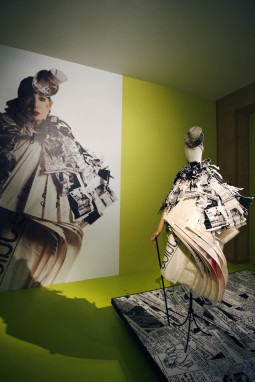
In 2009 MoMu - Fashion Museum Antwerp hosted the exhibition ‘RRRIPP!! Paper Fashion’ that investigated the use of paper in fashion design and the historical importance of the paper dress.
THE EDITOR’S COLUMN – Paper Fashion
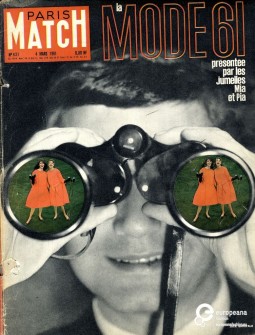
This month, the Europeana Fashion Blog will focus on the many ways fashion has been represented in prints, drawings and photographs.
Fashion stands between the material production of clothes and accessories and the construction of myths and stories around these objects. That’s why the Europeana Fashion portal is dedicating this July to what we decided to call ‘paper fashion’: a journey throughout the materials hold in all the collections of our partners, crossing boundaries and proposing a new insight into these precious files that build up the Europeana Fashion collection.

The cover of Paris Match n 621, 4 March 1961, presenting the latest fashions of 1961, Courtesy MUDE Museu do Design e da Moda, Colecção Francisco Capelo
Illustration is an umbrella term that collects different experiences related to the depiction of fashion: from sketches and drawings, to plates, real and utopian scenes: all these different techniques were employed in order to communicate within a certain network of people and convey messages and ideas. In this sense, Illustration is a language, capable of giving informations when the material object cannot be moved – or has not even been made yet.
Not always linked just to small circles of experts – as designers, pattern makers and fashion illustrators – fashion and its eccentricities were also, very often, the favourite subjects of caricatures and satire, which played on the effects the changes in silhouettes, apparel and appearance had on social interactions in urban scenarios. These plates help us understand how fashion was perceived by the public and how its significance has been mediated via its portrayal.

Fashion plate, 'The Newest Fashions for April 1860' from The Ladies Gazette of Fashion, Courtesy Victoria & Albert Museum, CC-BY-SA
Photography also plays a big role in the representation and circulation of fashion; this is true not only for editorials and catwalk pictures, but also for private photographs, where the protagonists choose carefully how to present themselves – and thus how to be immortalised.
The force of all these various kinds of depictions lays in the collaborations between different personalities, in the use of various styles and, above all, in the power of these images to create a whole new world around an object. Therefore the potential of these ‘paper fashions’ is immense. Each mode of representation tells a different story about fashion and unveils its various meanings, and this is our aim this month: to present some of , and give sparks to reflect on the meaning of these kind of material within a fashion collection.
Get ready to discover more about how fashion has been represented, and to listen to some of the stories these images tell: find your favourites this month on the Europeana Fashion portal.
Abaixo as Fronteiras! Vivam o Design e as Artes at MUDE

At MUDE and MACE, the exhibition Abaixo as Fronteiras! Vivam o Design e as Artes challenges the hierarchies and reflects on the intersections between design and art.
The exhibit explores the links between design and art in a broad sense, trying to understand what defines the frontiers of two disciplines, and possibly proposing to overcome these boundaries in order to get a richer picture of the connections between two fields so intertwined. This reflection becomes material in the display, which presents objects that stand on the blurred line that divides the disciplines. Drawing from the wide collection of the museum archive, the exhibition puts on stage a dialogue, where the object themselves serve as the main actors.
The role of fashion in this dialogue is, at the same time, complex and essential; fashion itself can be considered a case study to understand the fluidity of the relationship between function and contemplation, innovation and craftsmanship, reproducibility and uniqueness. For this reason, the exhibition features designs by the likes of Alexander McQueen, Ana Salazar, Azzedine Alaïa, Christian Lacroix, Comme des Garçons, Dirk van Saene, Dries van Noten, Gianni Versace, Issey Miyake, Jean-Charles de Castelbajac, Jean-Paul Gaultier, Maison Martin Margiela, Vivienne Westwood and Walter Van Beirendonck alongside other names from the industrial design, architecture and art scenes.
In presenting different styles, chronologies and angles, the exhibition asserts the role of fashion as catalyst in the comprehension of the contemporary value of the concepts of ‘design’ and ‘art’ and, above all, in the interdisciplinarity of the two. The Lisbon display focuses on creators and authors, and fashion designers have historically been pioneers in questioning any static definition and giving material shape to ideas concerning the encounter of personal feelings, the body and the environment.
The exhibition serves also as a reflection on the value of collecting fashion; the destitution of the hierarchy between fine and applied art underlines the value of fashion objects as storytellers, whether they are unforgettable icons of an era, or material memories of everyday and mundane experiences. Fashion in fundamental in museum collections because of its social value, and clothes and accessories are a tangible document of the historical changes in attitudes, tastes and opinions.
Discover more about the exhibition on MUDE Website and explore the MUDE Fashion collection on the Europeana Fashion Portal.
Exhibiting Dress: Enganging with the Past and the Present
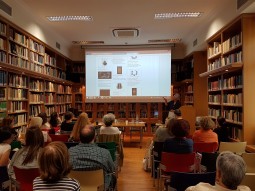
The symposium was organised in collaboration with the Netherlands Institute at Athens, and was part of the celebrations in Athens of the International Museum Day 2016. ‘Exhibiting Dress: Enganging with the Past and the Present’ - the title of the event - invited many experts to investigate the approaches and current trends in exhibiting dress in museums, aiming to find innovative ways to pursue the practices of display and exhibition making.
New Theme: ‘The Zoo’
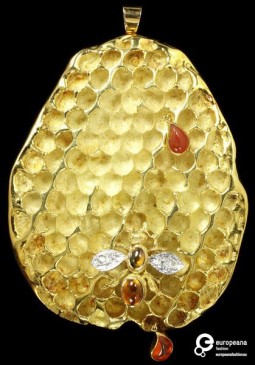
There are many less obvious ways in which animals contribute to fashion, and this theme focuses on all the designs from Europeana Fashion's collection which feature animals in their design



